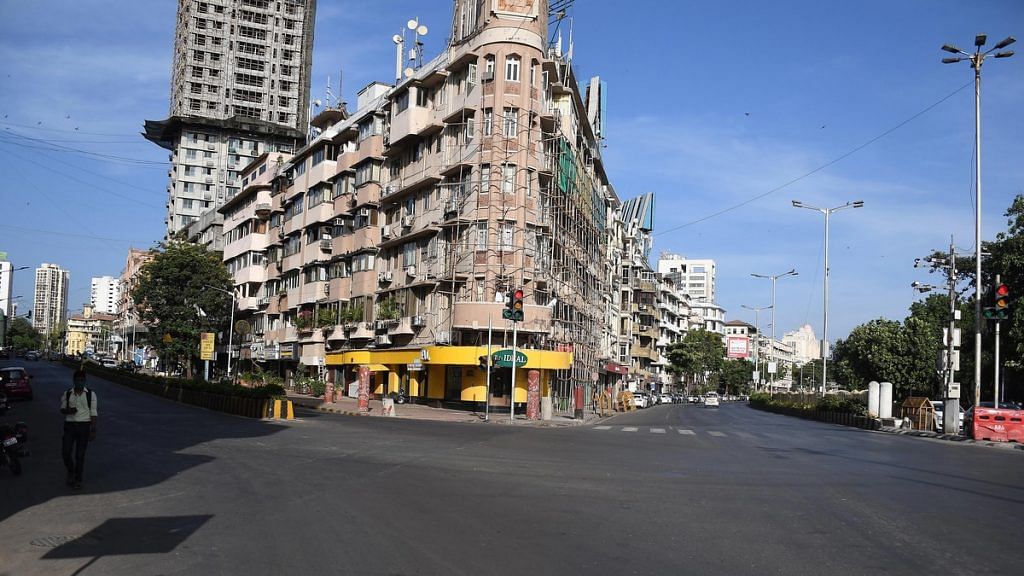Mumbai: In a small glimmer of hope, Mumbai, one of the first cities to be gripped by the second wave of the Covid-19 pandemic, is showing signs of flattening the curve.
The city, which was recording 10,000 to 11,000 new Covid cases every day at the beginning of April, with a daily positivity rate of 20 to 30 per cent, has seen a steady decline in the number of new cases each day. Over the past three days, Mumbai has been adding less than 6,000 cases to its Covid tally with a test positivity rate of 14.6 per cent, 13.75 per cent and 9.1 per cent.
As of 25 April, Mumbai had 75,740 active cases, and a cumulative Covid caseload of 6,27,651. The city recorded 5,542 new cases Sunday and 5,888 Saturday.
On Monday, the number of new cases fell to under 4,000 for the first time this month, with the Brihanmumbai Municipal Corporation (BMC) recording 3,876 cases, though the number of tests conducted were also lower than usual.
However, civic officials and health experts say it is too early to rejoice and declare that the city has turned a corner.
Om Srivastava, a city-based infectious disease expert, told ThePrint, “It might be a bit premature to call this a decline. The lockdown is the biggest reason for this dip. We will have to wait and see how the situation is for the next two-three weeks at least.”
Also read: Not vaccine supply, distribution by states also the problem in slowing phase one, says govt
Lockdown helps, but BMC in ‘wait-and-watch mode’
Maharashtra has been in some form of a lockdown since 5 April. Initially, the state government had only kept the lockdown confined to weekends, while movement through the week was allowed with certain restrictions.
From 14 April, the government declared a complete lockdown, including restricting Mumbai’s public transport, especially its local trains, only for essential service workers. The state government later further tightened it by allowing people to step out for grocery shopping only between 7 and 11 am.
Dr Shivkumar Utture, president of the Maharashtra Medical Council, said, “A lockdown has two aspects — medical and economic. I am purely talking about it from the medical aspect that it cannot be a coincidence that we called for a lockdown after which the numbers came down.”
April’s peak in terms of the daily addition of Covid cases came a day before restrictions were imposed. On 4 April, Mumbai recorded 11,163 new Covid positive cases with just 36,900 tests — a positivity rate of 30 per cent.
However, the number of new cases started to fall steadily as the civic authorities and the city’s police tightened movement during the lockdown. In seven days from 19 April to 25 April, Mumbai recorded an average of 6,905 new cases every day.
Utture also sounded a word of caution, urging people to follow precautionary measures strictly once curbs are lifted in order to maintain the downward drift.
“We will have to wait and see what the situation is once the lockdown is relaxed. But I hope that people have at least now and learnt that if they don’t follow the basic protocols of masking and social distancing, such measures will be inevitable,” he added.
Daksha Shah, deputy executive health officer at BMC, told ThePrint, “We are currently in a wait-and-watch mode. This could be the result of the weekend lockdown measures and now the extended lockdown, stricter containment zones and more rigorous contact tracing. The positivity rate daily keeps fluctuating, but by and large the trend is that it is going down.”
She added, “But the BMC wants to wait for two-three weeks before calling this any kind of a trend. We will have to see how things are going especially after the lockdown curbs are relaxed.”
Also read: How ‘oxygen langar’ at this Ghaziabad gurdwara is helping save ‘hundreds of lives every day’
Tests dip, but positivity rate too plummets
Along with a drop in number of cases, the number of Covid tests that the BMC conducts every day have also dipped to about 40,000 a day from a peak of 56,200 on 13 April.
However, the BMC has returned to maintaining a ratio of over 60 per cent of the total tests being RT-PCR, considered to be the gold standard for Covid testing, though these can take up to a day to give results.
Before the lockdown, the BMC had ramped up its rapid antigen testing by randomly testing visitors at malls, restaurants, and other crowded public places. At one point earlier this month, Rapid Antigen Tests — which give results within 30 minutes, but are considered less reliable — accounted for 50 per cent of the BMC’s total testing.
However, this changed as the lockdown forced most people to stay indoors, reducing the quantum of Rapid Antigen Tests.
Moreover, the test positivity rate was 13.6 per cent Monday with the city having recorded 3,876 cases with 28,328 tests.
Utture said, “This is definitely a positive inclination that Mumbai is improving. But we can say that we have things under control only when the rest positivity rate drops to under five per cent.”
In the first wave of the pandemic, the BMC had reached this milestone of maintaining a positivity rate of under five per cent only in December, nine months after the first Covid positive case was detected in the city.
Also read: AIIMS scraps contact-tracing of Covid-exposed healthcare workers, pvt hospitals follow suit
